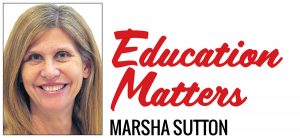Education Matters: Grading policy at San Dieguito ignites community
May 20, 2020
The San Dieguito Union High School District’s Board of Trustees got an earful at the May 14 special board meeting.
At issue was the announcement from the district office six weeks ago to change the grading policy to a mandatory credit/no-credit, with no option to choose letter grades, for the period since March 13 when schools closed due to the coronavirus pandemic.
When many parents and students learned of this, an uproar ensued.
 Succumbing to pressure, including threats of a recall, school board President Beth Hergesheimer agreed to hold a special meeting May 14 with an action item on the new grading policy.
Succumbing to pressure, including threats of a recall, school board President Beth Hergesheimer agreed to hold a special meeting May 14 with an action item on the new grading policy.
The May 14 agenda item, submitted by district Superintendent Robert Haley, asked the board to approve “that all SDUHSD students will receive a mark of Credit/No Credit for Semester 2 of the 2019-2020 school year.”
Hergesheimer said the board received 174 written comments, all of which are posted on the district’s website. Of the 174 comments, 86 were anonymous, and the rest were identified by name.
All but two of the 174 comments opposed the credit/no-credit policy and asked the board to allow students to choose between C/NC and a hold harmless letter grade.
The term “hold harmless” means that a student’s grade cannot be lower than it was on March 13 when schools closed.
In a questionable legal move, the district chose to hear only 10 of the 30 speakers who asked to address the board, the 10 selected at random.
Those who spoke protested the credit/no-credit decision.
A handful of written comments addressed the uneven level of distance teaching, saying some teachers are reaching out well to students while others are practically absent. One bemoaned the lack of access to labs.
Of those who provided comments, many were students, mostly high school juniors, who wrote that they deserved to keep their grades and be rewarded for their hard work.
Students speak out
“I find this current policy morally incorrect based on American principles, which is the idea that if one works hard he or she is rewarded,” wrote a junior from Canyon Crest Academy who said his grade point average was not “anywhere close to the top GPAs” but still believed that “tossing a student’s grades from third quarter in the trash is ethically wrong.”
“This is America so you should have sent a democratic message to students by getting input from the local student community,” the student wrote. “Instead, you were sending the message that you don’t have any empathy for the sweat, stress, and tears that students put into the third quarter grades.
“So, right now it’s time to redeem yourself and show that you actually care about the effort students put into past grades by agreeing to the option of choosing between credit/no-credit and harmless letter grade.”
“Straight As will be weighted the same as Ds and Cs which is blatantly wrong,” wrote another.
“I had a bad sophomore year and have been using this year to get my grades up,” wrote a junior from La Costa Canyon High School. “Please please please change your decision to allow us grades or even the choice between grades and credit. I have several friends who are not studying and would take the credit but I have worked very hard to get these grades and I deserve to keep them.”

“All I ask is for a choice to show my grades. I need merit scholarships and cannot do that with just my last semester grades. I want to show my growth over the years,” student Carson McLachlan said. “One size does not fit all. Let us be individuals and give us a right to CHOOSE!”
“I cannot bring my GPA up with all of my hard work this semester if I only get a P for credit,” student Kevin Kent wrote.
“I understand that with this pandemic students have had a hard time learning and keeping up with work due to personal circumstances, but there are also other students including myself who have not let this obstacle stop them from continuing to work hard and maintain their grades,” wrote La Costa Canyon sophomore Sophia Colavin.
“Please allow all students to have a choice,” she wrote. “While credit/no-credit may be a blessing for some, it is a punishments for others. The students should decide what is best for themselves.”
Parents who were allowed to address the board, through the random selection process, included Victoria Bloise, who said the C/NC policy is itself inequitable.
“Removing individual choice does cause harm,” she said.
“With the hybrid grading policy, everybody wins,” said Maureen Farley Lucewicz, who added that some students have suffered from depression and anxiety over the C/NC policy.
The other side
Under pressure from constituents, the school board eventually voted to allow students to choose hold harmless letter grades or credit/no-credit.
Despite the outpouring of support for the choice option at the May 14 board meeting, it would be unfair to suggest that choice is a no-brainer.
The May 14 vote generated a petition objecting to the board’s decision and calling for the board to revert back to the C/NC policy, based on three reasons:
1. Lack of trust. “To suddenly turn around and pull the rug underneath us is a disgrace to many people in the district, and should not be tolerated. There ought to be transparency among the district, and much of that should come from staying true to one’s word, which the district has evidently not done.”
2. Lack of representation. “Students’ opinions were not taken into account, and the board hastily made a decision that was not representative of the entire district.”
3. Lack of equality. “The entire purpose of Credit/No Credit was to ensure equality among everyone, including people whose lives have been affected greatly by this pandemic. By switching into these options, it is providing a foundation for bias, inequality and injustice among multiple aspects.”
A parent group supporting choice responded to each of the three reasons: 1) the community was never given a chance to present their views on the C/NC decision from the beginning, 2) student voices were indeed heard and students were well-represented at the May 14 meeting, and 3) offering choice will result in less bias, inequality and injustice than C/NC only.
In an email exchange after the board’s vote, Canyon Crest Academy math teacher Brian Shay presented compelling reasons for C/NC.
“I do understand the other side of the situation (hard working students who think they are being undermined by having a C/NC grade),” Shay wrote. “I understand that there are students who are working hard and feel they rightfully deserve a letter grade.”
But trying to assess students remotely is challenging, he said. “I do not understand how I could give true and honest letter grades in this learning dynamic.”
Without knowing who is writing the essay or taking the test, it’s difficult “to properly and fairly assess students,” Shay said. “How do I know that the work they submitted really is their work?”
“Now students will stress about potentially bringing their grade up, or to decide whether to have a letter grade or not and the implications therein. Teachers also now need to stress about how to measure student performance and attach a meaningful letter grade to it.”
Shay pointed out that many students are now living in difficult situations. He said they could be babysitting or having to teach younger siblings, they may need to share computer time with parents and siblings, their parents may be front-line workers, the family may be suffering financial stress, parents may have been laid off, or any number of other uncertainties confronting students trying to learn from home.
“Many good working kids cannot do their best work in this dynamic,” Shay said.
Teacher support for C/NC
Teachers, too, are working from home under challenging conditions, with many home-schooling their own children, facing difficult financial circumstances, and juggling child care, work and family responsibilities, Shay said.
“We also have been teaching and learning with the mindset of C/NC, and now to make a significant pivot with less than three weeks left in the grading period is challenging,” he said.
“We redesigned our assessments and teaching to be for Credit/No-Credit and have been following that plan since Q4 started after Spring Break,” Shay said.
“Switching now, with barely three weeks left in the school year, is irresponsible and inappropriate.
“Yes, it is not ideal, but it is what is best for the majority of our students and teachers. Changing the goal this late in the game is not right or fair.”
Shay said students have sent dozens of emails expressing their concerns and anger about what happened at the May 14 board meeting.
“I really feel like a vocal minority demanded this change and the majority was silent because they did not think that this change was going to happen,” he said.
Regarding the charge that C/NC allows teachers to do less work, Shay said that’s not true.
“Teachers still want students to be successful in their class and future classes,” he said. “If a teacher does less work to prepare their students, it will only hurt their students, and I don’t know of any teacher who would do something like that.
“My colleagues are doing great things and have gotten very creative. And the ability and freedom to do that was in part enabled by the fact that we were only grading as Credit/No-Credit.”
“Most district employees are in agreement with offering only one option and that one option being C/NC,” he said. “The district admin. and teachers talked about this extensively prior to Dr. Haley making the announcement.
“The best course of action to avoid devaluing and adding more confusion to a transcript and GPA is to REMOVE the choice.”
Importance of grades
After the pandemic forced schools to close, the California Department of Education issued an advisory to school districts, stating, “The decision of whether or not to require graded work from students is a local one” — adding that districts “should weigh their policies with the lens of equity and with the primary goal of first, doing no harm to students.”
Many colleges have not yet settled on how to evaluate next year’s graduating class, so this year’s juniors have good reason to be concerned and confused about whether grades for the spring of 2020 will matter.
Haley told the board that the situation has been a “constantly evolving landscape” since mid-March and that he’s read hundreds of emails and talked with many students and parents on this issue.
He said Bryan Marcus, associate superintendent of educational services, took the lead on the grading policy.
Marcus said the hope with the C/NC policy was “to take the pressure off students,” although he acknowledged that it “unintentionally created somewhat of an issue.”
Marcus said it was a collaborative process to arrive at the decision, saying it was based on the information they had at the time and that they made their best effort to provide equity and fairness.
“We get the importance of grades,” Haley said, suggesting that the board could decide not to take action that day and delay until the following week to explore alternatives.
In board discussion, Trustee Joyce Dalessandro picked up on that theme, saying, “Does it make sense to make this decision today?”
Trustee Kristin Gibson also suggested that perhaps staff might come back with options.
The idea of postponing the vote until May 21, when there would be less than three weeks left of school, was clearly a non-starter. The delaying tactic, if indeed that was a strategy, failed.
Board discussion
Before anyone could make a motion to support Haley’s request to maintain the C/NC policy, Trustee Maureen Muir moved to adopt a hybrid model for grades that would allow students to choose either a hold harmless letter grade or C/NC for spring 2020.
Trustee Melisse Mossy seconded the motion.
“Give me one reason why we wouldn’t choose choice? What’s the argument against it?” asked Muir, who said she recognizes the motivation for grades.
Haley said the district would need to explain the hybrid policy on each transcript and student profile.
“You’re talking about the problem the staff will have, not what the students will have,” Muir responded, saying choice is a win-win for everyone.
Dalessandro said there were “a lot of compelling reasons to do it differently than we had originally planned.”
Gibson said that both options are valid and both have drawbacks, although her preference was for C/NC.
“I wish we had heard from a parent who wants credit/no-credit,” she said.
She also worried about altering the policy so late in the school year.
“The fact that we’re changing mid-stream could be problematic for some students who were operating under the credit/no-credit policy,” she said.
“This issue has fragmented our community … (and) the controversy needs to come to an end,” Gibson said.
“I don’t think there’s a perfect answer,” Mossy said. “I really wish our kids weren’t so stressed.”
Marcus asked if Muir’s motion applied to grades 7 and 8, or just grades 9-12. Muir accepted an amendment to her motion to keep C/NC for middle school students and provide choice for high school students.
“With reservations I will say yes,” said Hergesheimer, commenting that choice has its own problems.
The motion to allow for choice of either hold harmless letter grades or C/NC for high school students, with only C/NC for middle schoolers, passed 5-0 — and included an enthusiastic “aye!” from Mossy.
Recall threats
It should never have come to this.
Other districts seem to have proceeded with these decisions without the friction that San Dieguito has experienced.
The school board, students and parents should have been involved in this discussion from the beginning, rather than the superintendent rolling it out without seeking more feedback from stakeholders. All this delay, drama and disruption could have been avoided.
Even after there were early protests to the C/NC policy, Haley at the April 21 board meeting asked board members for consensus to proceed with C/NC.
Three of the five trustees — Dalessandro, Gibson and Hergesheimer — verbally supported Haley. No actual vote was taken at that meeting.
Because this was mishandled from the outset, the board can now expect an outcry from the other side when the district brings back its recommendations on how to implement the choice option at its next board meeting on May 21.
Public officials are elected to make the hard decisions and vote in the best interests of students. This was a tough call and was perhaps one of the most difficult this board has had to make in recent years.
Regarding the threats to recall board members who supported one option over the other, let’s leave recalls for criminal activity. I doubt any of these trustees voted on this issue without careful thought.
The caption accompanying a May 14 NBC7 news story on this issue read, “The district came to a decision that should make both sides happy.”
Sadly, it did not.
Marsha Sutton is a local education journalist and opinion columnist and can be reached at suttonmarsha[at]gmail.com.
Columns represent the views of the individual writer and do not necessarily reflect those of the North Coast Current’s ownership or management.
encinitas current, cardiff current




